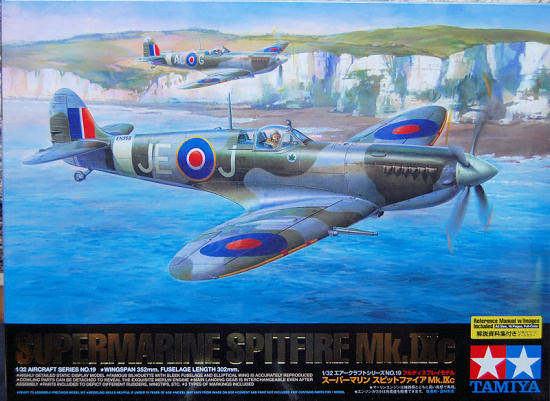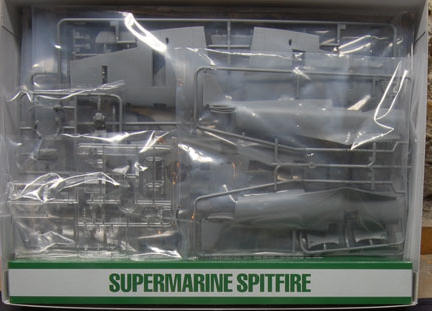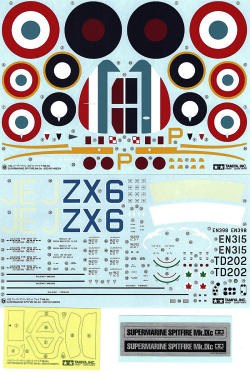
Tamiya 1/32 Supermarine Spitfire Mk.
IXc
| KIT #: | 60319 |
| PRICE: | $159.00 MSRP |
| DECALS: | Three options |
| REVIEWER: | Andy Abshier |
| NOTES: | Not just the finest kit of a Spitfire ever produced, it is possibly the finest plastic model kit of an airplane ever produced. |

| HISTORY |
In September 1941 the Focke-Wulf Fw-190 was
introduced into Luftwaffe service.
RAF pilots in Spitfire Mk. V's encountering the new type immediately found the
Fw-190 to be superior to the Spitfire Mk. V in all parameters, and RAF losses in
operations over
Fortunately for the RAF, Supermarine had
already been testing a new variant of the Merlin engine, the Merlin 61, in
response to the RAF's request to develop an engine with improved high-altitude
response. The Merlin 61 placed two
supercharger blowers in series with an intercooler, greatly improving
performance. The 61 engine's
improvement over the Merlin 45 engine that was then powering the Spitfire Mk. V
was dramatic, increasing effective horsepower at 30,000 ft. from 720 hp. to 1020
hp.
The resultant Merlin 61 Spitfire, the Mark IX,
was basically a stop-gap airplane based on the Spitfire Mk. V and using, as much
as possible, the Mk. V's structures and planform.
Changes from the Mk. V included revised under wing radiators, revised
engine bearers, a longer cowling, and a four-bladed propeller.
Later improvements included a revised under-cowling intake, extended
rudder, revised mass counterbalances for the horizontal stabilizers, and revised
cannon fairings. Although the Mk. IX was heavier than the "definitive" Merlin 61
types on order, the Mk.
The first Mk. IXc Spitfires to enter service were with 64 Sqn., RAF, in June 1942. The "interim type" turned out to be the most-produced of all Spitfire variants, and the type remained in service until the end of the war. Spitfire Mk. IXs would also fight for the Israeli Defence Force in the 1948-49 war.
| THE KIT |
 When the kit
was first announced in September 2009, sprue photos and built-up test shots were
shown at that time, and what was on view was tantalizing.
With the kit now in hand I can say, for myself at least, that what we saw
in pictures on the Internet does not do the kit justice.
When the kit
was first announced in September 2009, sprue photos and built-up test shots were
shown at that time, and what was on view was tantalizing.
With the kit now in hand I can say, for myself at least, that what we saw
in pictures on the Internet does not do the kit justice.
Upon opening the large and heavy box, one is
greeted with sprues stacked bottom to top, and a lot of them, 26 in total.
In addition to the plastic parts, there is a sprue of vinyl parts for the
tires and engine hoses, two photo-etched frets, bags of metal fasteners and
rods, magnets to hold the engine covers in place, and the engine covers
themselves packaged in a small box within the box, and inside cellophane-wrapped
individual trays!
Molding is superb overall.
In the 26 sprues I did not find any flash, short shots, or improperly
placed ejector pin marks. On the
major external surfaces sprue gates run to the gluing surfaces, so that when the
areas are cleaned up they won't show on the outside.
Surface detail is all engraved, including panel lines, rivets, and even
screw heads.
The wing parts are riddled with openings so
that inserts for the "C" wing can be placed; were it anyone's kit but Tamiya's
this would be cringe-worthy, but I suspect the inserts will drop right in.
This also suggests that other versions of the Spitfire may be
forthcoming. No guns or gun bay
parts are provided, but with the separate cannon covers
already there (both early and late types), I wouldn't be surprised if the
aftermarket stepped in to help.
Interior detail in the fuselage is very
comprehensive. The cockpit, with 66
parts, is all there, including the proper floorless presentation, early and late
type gun sights, and photo-etched seat belts (the belts appear to be a Sutton
harness, which would be accurate for an early IXc--consider replacement with a Q
harness if you're building a late IXc).
You're not going to need aftermarket help, save for one tiny fix,
detailed below.
A full Merlin 61 engine is provided.
89 parts make up the engine--and that's not including the six exhaust
stacks for each side (both round and fishtail), each individually molded and
with realistically hollow ends easily the equal of Ultracast's best work.
The engine can be shown fully opened or fully covered or anything in
between, with tiny magnets used to hold the engine covers in place.
Photos of built-up models show that the engine covers fit perfectly when
they are in place.
I should mention also that the fuselage halves
are molded from the firewall back, again suggesting that earlier Spitfire
variants are on the way. The
fuselage also has inserts for the fixed tail wheel on the IX, and certainly
suggests that retractable tail wheel variants such as the Mk. VIII are
forthcoming.
Tamiya left no stone unturned on this kit.
Even the wheel wells, usually simplified in most Spitfire kits, get
attention here, with the walls of the round portion of the well fully detailed
and made up from 5 parts on each side.
Speaking of the landing gear, two complete sets of main gear are
provided, so that the modeler can display the completed model gear up or gear
down by interchanging the appropriate struts using poly-caps and screws.
Two pilot figures are included.
One is a seated pilot in full flight kit, the other is a standing pilot
in an RAF flight sight, flying boots, and officer's cap.
Both are well sculpted and include separate arms and heads.
Instructions are very clear, and very lengthy!
They comprise 71 steps start to finish and given the complexity of this
model, I would recommend that they be followed implicitly.
There are alternate parts for early and late Spitfire IXs and mounting
holes to be opened (or not opened) so decide which version you want to build
before starting. Color callouts are
in Tamiya colors, so have a cross-reference handy if you're using paint from
other lines.
A bonus 16-page booklet is provided, printed on
full-color glossy stock. It
includes a history of the Spitfire, a nice graphic explanation of the wing types
fitted to the Spitfire (a nice primer for the aspiring Spitfire boffin) and
reference photos of a
Few aircraft subjects in our hobby inspire as
much passion as the Spitfire and the boffins can be a very tough lot to please.
Since the kit has come out, I've been monitoring the message boards for
discussions of this kit. The
complaints, if you can even call them that, about this kit between all of the
message boards I've read boil down to these:
1. The decal used to represent the artificial
horizon is in color, when wartime artificial horizons were black and white.
Easy fix--cut out the wrong instrument from the Tamiya decal, and use a
Reheat or Mike Grant Decals black and white artificial horizon as a substitute.
2. The flare storage rack for the seat (part
F48) was fitted only to early Spitfires, not the Mk. IXc--one more suggestion
that early variants are on the way.
Easy fix: leave it off!
3.
The early-style cannon bulges came in for early criticism from the photos of the
test shots and sprues. The
consensus I've seen is that the Tamiya-provided setup may have been fitted, but
it was not the most common type. I
would not be surprised if an alternate early-style cannon cover was done in
resin.
Aside from the early-type cannon bulges, I've
seen no complaints about the outline, dimensions, or overall look of the model.
None. Tamiya dead-ass effin' nailed
it.
 Two decal
sheets are provided, including markings for three aircraft:
Two decal
sheets are provided, including markings for three aircraft:
1.
EN398, JE-J, Kenley Wing, RAF Kenley July 1943, flown by WC J.E. "Johnnie"
Johnson. Dark green/ocean gray
camouflage over medium sea gray.
2.
EN315, ZX-6, 145 Sqn., Polish Fighting Team,
3.
TD202, P, GC 1/4 "
Decals are sharply printed and in register.
Both red and green maple leaf
badges are provided for Johnson's aircraft; use which one you see fit..
The roundels have the proper shades for the blues and the reds for the
French and RAF markings. Yellow ID
bands, gunport tapes, full stenciling, and propeller tip markings are included
as well.
Tamiya decals get a bad rap, but they work well
if you soak them in warm water and use Micro Set for setting.
Micro-sol, except in very small amounts, causes these decals to wrinkle.
That said, aftermarket sheets are out there, or are on the way, so more
choices are available.
Paint masks for the canopy parts are provided. You'll have to cut them out yourself, but they will make your life easier when it comes time to paint. They are printed on Tamiya tape stock, so they will work well.
| CONCLUSIONS |
As I said in the data block, this may well be
the finest plastic scale model aircraft ever produced.
I don't see how anyone is going to top this kit anytime soon, or at all.
Now if Tamiya could just perform this kind of magic on the P-51B or D,
many of us would die happy!
Go buy or order one of these models.
Do it today. Pay full price
if you have to. You will be glad
you did!
Review sample provided by my wallet--because
you probably wouldn't believe this review if the kit wasn't bought by me!
| REFERENCES |
REFERENCE
Price, Alfred: Late Marque Spitfire Aces
1942-45; Osprey Aircraft of the Aces 5, 1995
If you would like your product reviewed fairly and quickly, please contact me or see other details in the Note to Contributors.